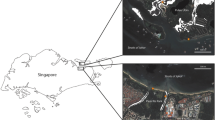Abstract
The distribution and growth forms of the mangroves on Zanzibar island (Unguja and Pemba) were investigated. Pemba island, with approximately 12000 ha of mangroves, had nine species; and Unguja island, with 6 000 ha, had eight. Average cropping intensities in Pemba island varied between 350–1937 cut plants per ha while in Unguja these were between 777–3567 cut plants per ha. In Pemba, mangrove forests were relatively less heavily exploited compared to those in Unguja, where clear felling was common. Charcoal, lime and salt production are the major activities which involve heavy utilization of mangrove wood.
The fishery resources (shellfish and finfish) associated with the mangrove vegetation were also investigated by examining the composition of fish catches at landing stations in mangrove as well as nonmangrove zones of fishing districts. A survey on the fauna associated with mangrove forests was also conducted. A number of the local commercial fish species were found to be associated with the mangrove vegetation. The fishes of the genusLethrinus and the rabbit fishSiganus were found to constitute the bulk of the fish caught from waters adjacent to mangroves using movable traps. The molluscPyrazus sp., which is commonly used by the local people for food and bait, was found only in the mangroves.
Similar content being viewed by others
References
Ahmad, N., 1966. Fish and fisheries of the Sundarbans. In Scientific problems of humid tropical zone deltas and their implications. Proceedings of the Daccar Symposium February/March 1964, UNESCO Paris: 271–276.
Cintron, G. & Y. Schaeffer-Novelli, 1983. Mangrove forests: Ecology and response to natural and man induced stressors. UNESCO Report in Marine Science # 23 ROSTLAC. 133 pp.
Griffith, L. A., 1949. Reconnaissance report on the forest problems of Zanzibar protectorate. Govt. Printer, Zanzibar. 21 pp.
Hoekstra, M., M. A. K. Ngoile, N. S. Jiddawi & C. Rotteglia, 1990. Census of the marine fishing units of Zanzibar in 1989 FAO/UNDP: RAF/87/008/DR/60/99/E. 119 pp.
MacNae, W., 1974. Mangrove forest and fisheries. Indian Ocean Program Publication Number 34 Rome, Indian Ocean Fishery Commission. 35 pp.
Semesi, A. K., 1988. Status and utilization of mangrove along the coast of Tanga, Tanzania. In Mainoya, J. R. (ed.), Proceedings of workshop on Ecology and Bioproductivity of marine coastal waters of Eastern African, Dar es Salaam, Tanzania, 18–20 January 1988. Faculty of Science, University of Dar es Salaam: 174–181.
Semesi, A. K., 1986. Zonation and vegetation structure of mangrove communities in Tanzania. In Mainoya, J. R. and P. R. Siegel (eds), Proceedings of Workshop on ‘Save the mangrove ecosystems in Tanzania’. Dar es Salaam, Tanzania, 21–22 February 1986. Faculty of Science, University of Dar es Salaam: 15–35.
Tarbit, J., 1976. Demersal Fisheries Research Terminal Report 1974–76. EAMFRO Annual Report 1976, EAMFRO, Zanzibar.
Author information
Authors and Affiliations
Rights and permissions
About this article
Cite this article
Ngoile, M.A.K., Shunula, J.P. Status and exploitation of the mangrove and associated fishery resources in Zanzibar. Hydrobiologia 247, 229–234 (1992). https://doi.org/10.1007/BF00008223
Issue Date:
DOI: https://doi.org/10.1007/BF00008223



